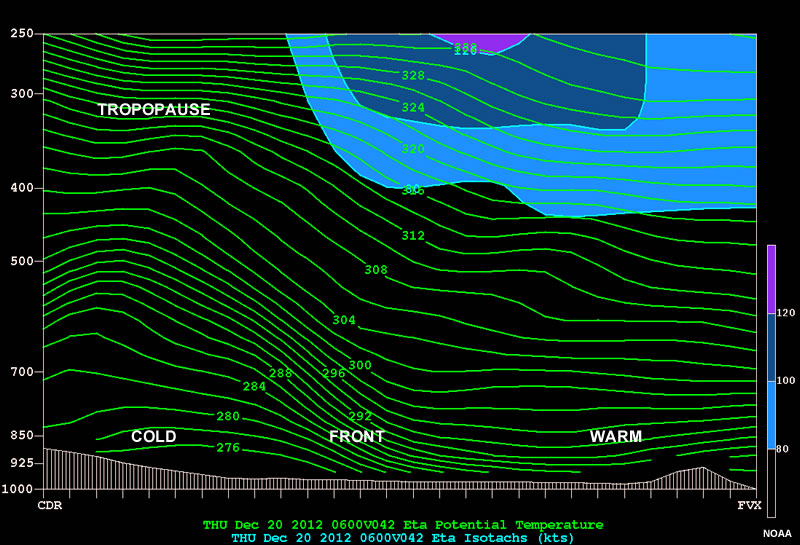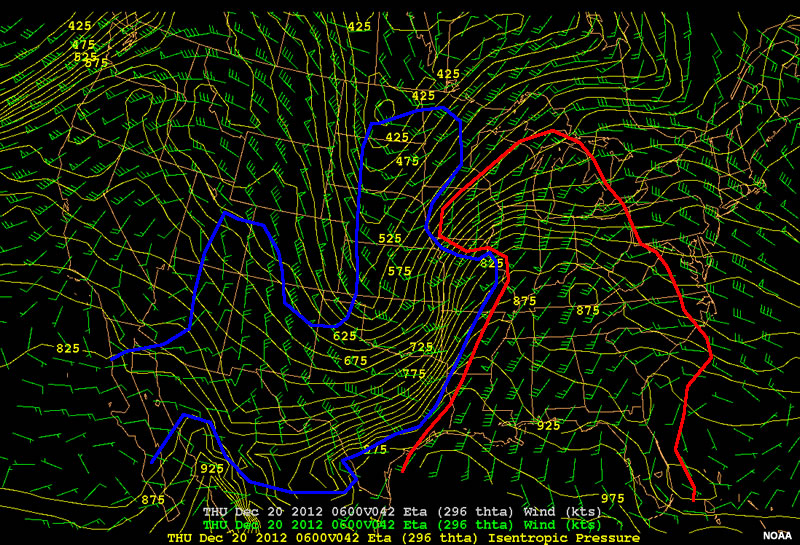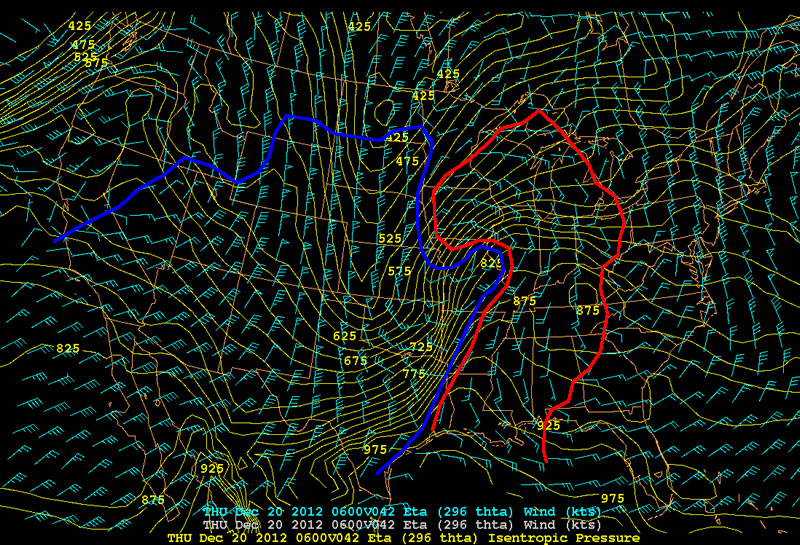Introduction
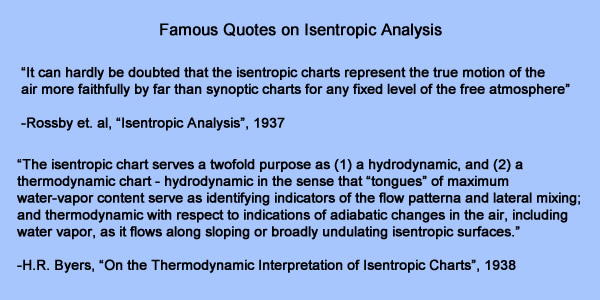
Before the switch to pressure coordinates prompted by aviation and WWII in the early 1940s, meteorologists regularly performed isentropic analysis as part of their analysis and diagnosis process. Isentropic analysis, as described by Rossby and many others, confers certain advantages in the forecasting process. Some utilities of isentropic analysis are outlined below:
- Diagnose and visualize vertical motion - through advection of pressure using system-relative flow
- Diagnose frontal boundaries and airmass types in the horizontal and vertical, and in a conveyor belts framework
- Depict frontogenetical and jet streak circulations
- Depict 3D transport of moisture
- Use isentropic potential vorticity (IPV) to depict the dynamic tropopause and tropopause folds
- Diagnose upper-level and dry static stability
- Diagnose symmetric instabilities
This lab will focus on the first two utilities, and will link the analyzed airmasses and frontal structures to the more standard way you have viewed weather structures and features in pressure coordinates.
Pre-Lab: Understanding Potential Temperature as a Vertical Coordinate
The troposphere is generally stable to dry processes, except in very shallow and narrow locations. So, most of the time we can safely use potential temperature as a vertical coordinate during synoptic-scale analysis.
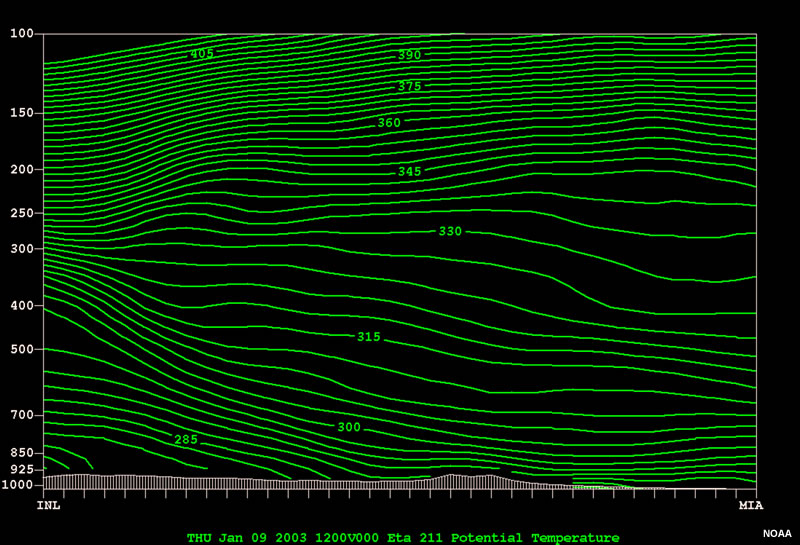
By definition, potential temperature increases with height, as it is the temperature that a parcel of air would have if brought dry adiabatically to a reference pressure level, usually 1000 mb, which represents the surface at sea level. The higher up the parcel begins, the more it will be adiabatically warmed before reaching the surface.
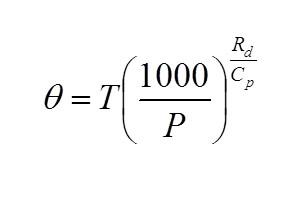
If we revisit the cross-section above, a few key points are apparent. First, potential temperature increases with height throughout the atmosphere (here from International Fall, MN to Miami, FL). Second, the more tightly packed the isentropes are in the vertical, the more statically stable the atmosphere is. Note the tightly packed isentropes above 200 mb - this is very stable air above the tropopause.
Finally, you may notice that some of the isentropes have a significant slope. The slope of an isentrope is much greater than that of a pressure surface for a given thermal gradient. Isentropes slope down toward warm air, and up toward colder air - the opposite of pressure surface orientations.
Thus, a typical frontal boundary may look something like what we see below. In this case colder air lies to the north, warmer air lies to the south, and very tightly packed isentropes exist where the two airmasses meet. Note that the isentropes are spaced further apart within the warmer airmass. This is an indication of lower static stability.
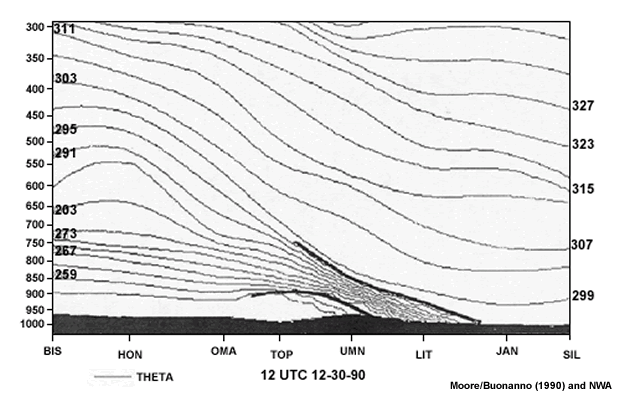
A cross section of a warm front shares similar characteristics. A warmer, southern airmass and a cooler, northern airmass, with a tightly packed area of isentropes in between, as seen in the lower left of this cross section from Bancroft, Ontario to Tallahassee, FL.
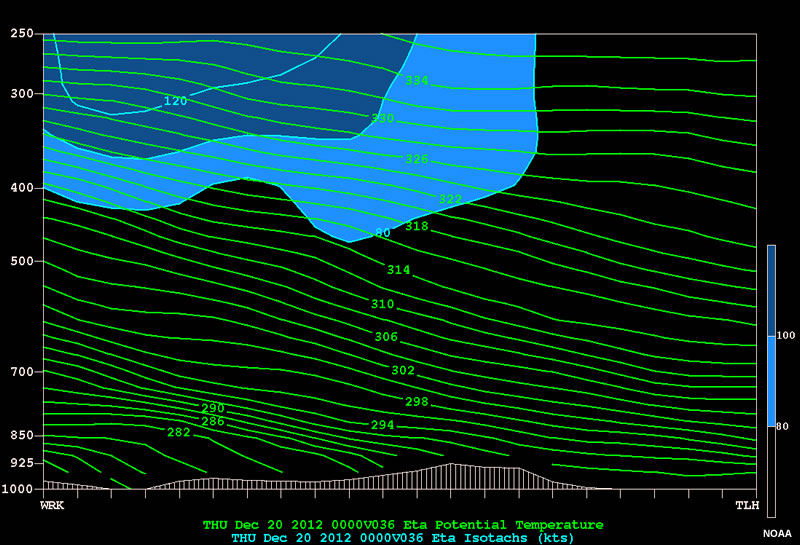
Here is another example - see if you can identify the airmasses by their temperature, the main frontal zone, and the tropopause.
Question 1 of 1
Drag the appropriate labels onto the cross-section to indicate where each airmass, the frontal boundary and tropopause exists. This cross sections runs from Chadron, NE (CDR) to Farmville, VA (FVX).
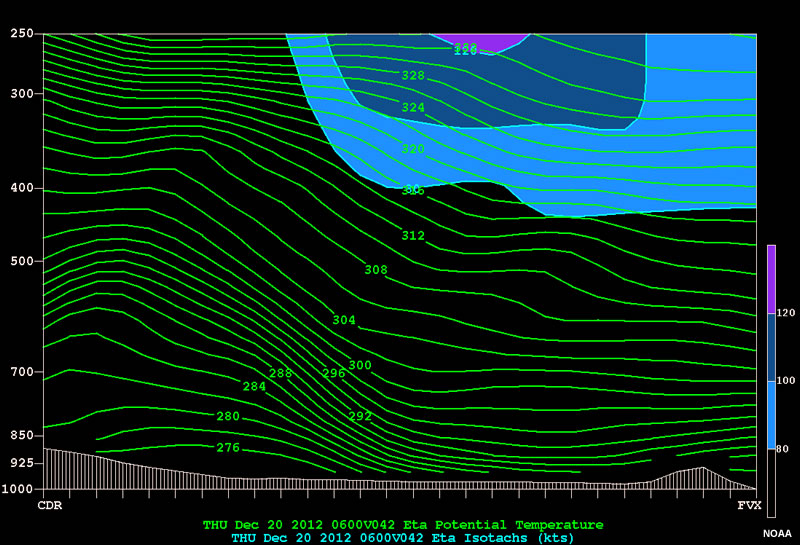
Much like the previous examples, cold air exists to the west, warm air exists to the east, and the tightly packed isentropes indicate the cold frontal boundary between the two airmasses. The tropopause is discernable just below the area at upper left, in which the isentropes become very densely spaced above about 300 mb. It quickly extends eastward and upward off the page above 250 mb.
Cross sections of potential temperature or equivalent potential temperature can also reveal the structure of jets and tropopause folds, as in this conceptual diagram:
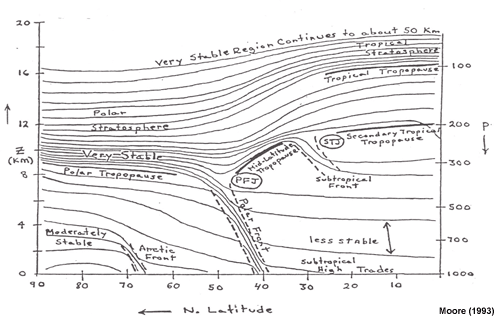
While we will not add isentropic potential vorticity in this lab, we can notice the placement of the polar front jet above relative to the front itself. The strength of ageostrophic circulations in this region will depend upon whether the cross-section cuts through the entrance or exit region of the jet, and upon the position of the front relative to the jet.
Since fronts generate their own ageostrophic circulations in an attempt to restore thermal wind balance (much like that of jet streaks), the horizontal spacing and alignment of the front underneath the jet can enhance or interfere with the vertical motions induced by the jet. In the example below, ascent from the left exit region of the jet streak and from the front are both aligned, producing very strong upward ageostrophic component in that region.
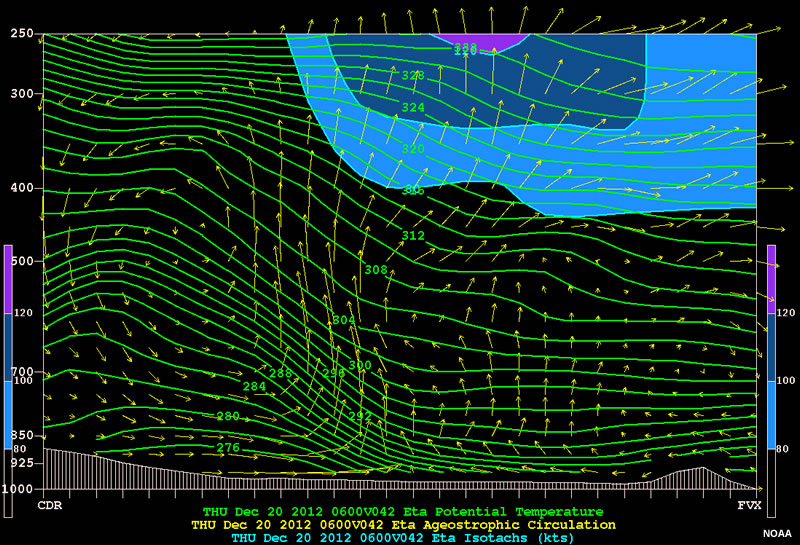
Pre-Lab: Understanding Potential Temperature and Equivalent Potential Temperature as Airmass Identifiers
Potential temperature is good identifying information for airmasses as we’ve seen in earlier cross-section views. Much like temperature and dewpoint in plan view, potential temperature and equivalent potential temperature can also highlight the locations of airmasses and fronts.
The map below shows potential temperature at 3K intervals across the US in spring. A cold front is visible as several tightly packed isentropes extending to the southwest of the low centered over the OK panhandle, while a warm front is similarly visible extending to the east/northeast. Warm air lies to the south of the warm front, while cooler air lies to the west of the cold front.

If we now look at equivalent potential temperature, which is the potential temperature of an air parcel that has first had all moisture condensed out before being brought adiabatically to a reference pressure, we should expect roughly the same pattern. Now the frontal boundaries are even more pronounced, as the temperature difference and moisture differences are visible. There is even an additional front that is visible - see if you can analyze and diagnose it in the question below.
Question 1 of 2
Use the pen to outline the area in which you notice a new frontal boundary in the vicinity of the low pressure center.
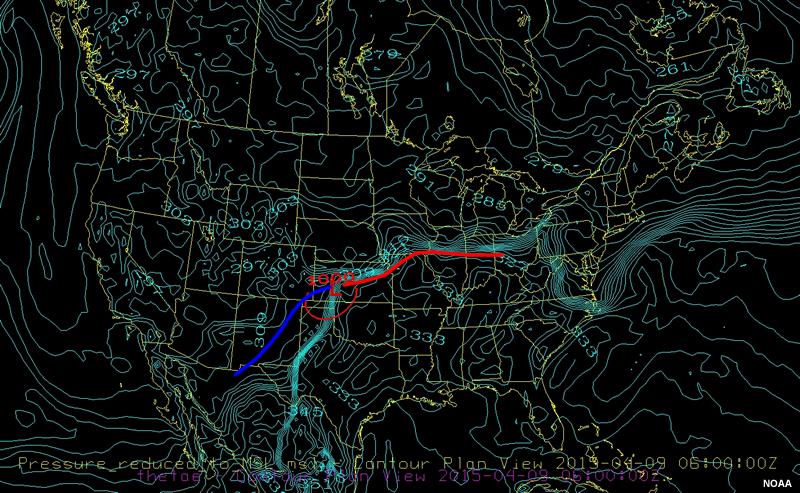
| Tool: | Tool Size: | Color: |
|---|---|---|
Question 2 of 2
What type of front do you think this is?
The correct answer is e.
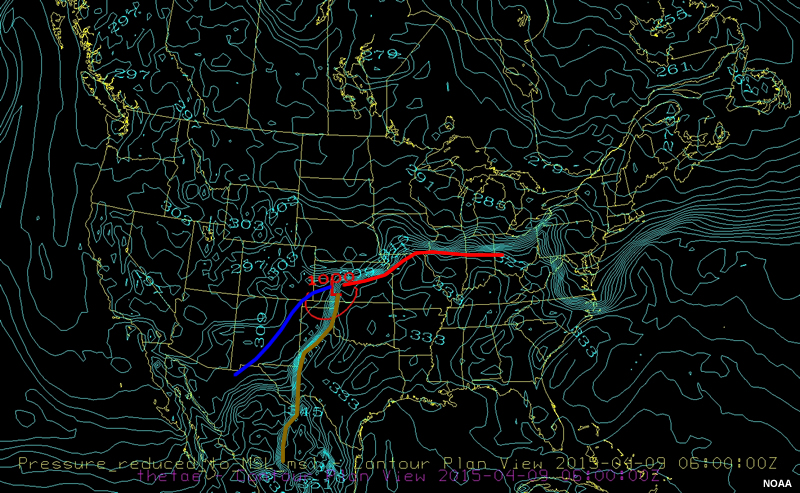
Because this front does not show up well in potential temperature, it suggests that the thermal gradient must be quite weak. Since it is captured well using equivalent potential temperature, we can assume that this is primarily a moisture gradient. Given its position in Oklahoma and Texas and timing during April, a dryline is probably a safe bet. The dryline position is outlined in brown.
In this way, potential and equivalent potential temperatures can serve as a good combination to quickly assess the main fronts associated with cyclones as well as more subtle boundaries - such as airmasses that have been significantly modified in temperature over time, but still retain their moisture properties.
Equivalent potential temperature, especially, is also quite useful for tracking the movement of these airmasses in a conveyor belts framework. High theta-E air within the warm conveyor belt moves northward and over the cold conveyor belt, while lower theta-E air can be tracked moving southeastward within the dry conveyor belt.
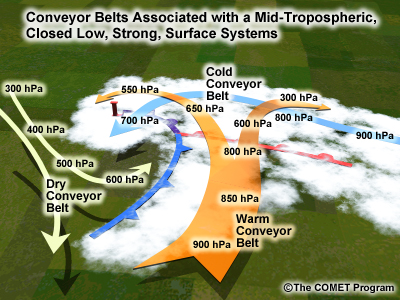
In the loop below, we can see the evolution of a midlatitude cyclone in a plan view of equivalent potential temperature and winds.
The warm conveyor belt and dry conveyor belt, along with warm and cold fronts all become clearly defined within a mature cyclone around frame 3. Toward the end of the loop, one can discern the TROWAL, or trough of warm air aloft, as evidenced by the extension of the high equivalent potential temperature values to the northwest of the low.
For more information on using potential temperature and equivalent potential temperature to identify and track airmasses in conjunction with satellite imagery, explore the Conveyor Belts module here:
Pre-Lab: Understanding Potential Temperature as a Tool to Diagnose Vertical Motion
Finally, and perhaps most importantly, isentropic analysis is viewed by many as a preferred tool for analyzing and diagnosing synoptic scale ascent and descent.
In standard pressure-coordinate map analyses, vertical ascent can be diagnosed, but in a piecewise, or “ladder” sense across multiple pressure level maps. Upward motion and moisture/precipitation generally appear to be separated from the advection that caused them on a single pressure level!
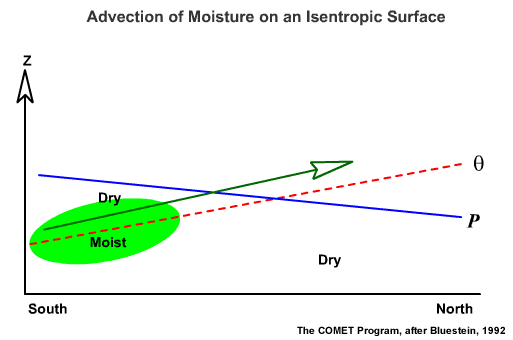
In the diagram above, we have a generic situation in which warm, moist air is slowly ascending to the north in a warm conveyor belt. Looking at the region using the standard pressure level, p, over time, the moisture would seem to appear from nowhere as it emerges from a lower pressure level.
But if we examine the region using isentropic surfaces, we can view the advection and ascent that are causing the precipitation together in the same chart. The moist air parcel above appears to naturally follow the isentropic surface! This is similar to what we saw in the cross-section views of fronts earlier - cold air will flow to the south and downward, while warmer air will flow to toward the north and upward, following the shape of the isentropes (until latent heat is released, that is).
In fact, in absence of diabatic processes and mixing, air will flow along potential temperature surfaces, since potential temperature is conserved during adiabatic processes. In this way, air parcels with a specific potential temperature value are restricted to flow along the isentropic surface of that value, much as with a material surface.
Thus, we can plot wind vectors and contours of pressure on a specific potential temperature surface to see just how much air is ascending or descending.
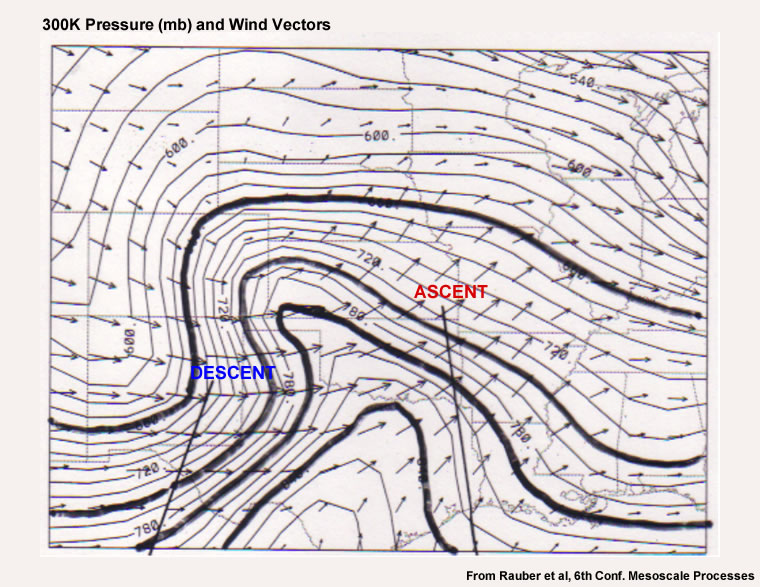
In the above diagram of pressure and winds plotted on the 300K isentropic surface, we can see broad westerly/northwesterly flow that defines the dry conveyor belt along with broad southwesterly flow that defines that warm conveyor belt. If we examine the pressure levels closely, we see values of 600 mb in western New Mexico, which is within the dry conveyor belt. Wind barbs indicate that air is flowing to the east on this isentropic surface. We can see that the pressure values increase dramatically between this area and the panhandle of Texas. Neglecting diabatic processes, this means that the air in this region on the 296K surface must be sinking!
We can see a similar but opposite process within the warm conveyor belt. Pressure values are about 780 mb over Louisiana, and winds are flowing across progressively lower pressure levels to the northeast, reaching 700 mb over central Missouri. Neglecting diabatic processes, this means that air on the 300K surface is rising, since the pressure is decreasing! Including diabatic processes, the rising motion would be even more pronounced!
Looking at another example, let’s analyze the areas of ascent and descent on the 296K surface.
Question 1 of 2
Outline the full extent of the area of ascent using the red pen, and descent using the blue pen.
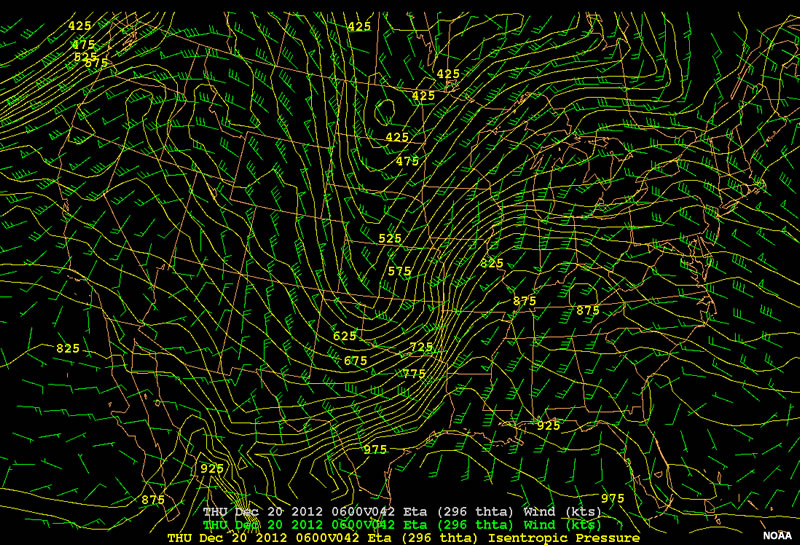
| Tool: | Tool Size: | Color: |
|---|---|---|
The area outlined in blue shows descent, beginning with the northwesterly winds that cross the 425 mb through 625 mb contour across the Great Plains. These winds flow to progressively higher pressures until the 825 mb contour over Missouri, Arkansas and Texas, where the winds become parallel to the contours and the pressure values begin to increase to the east. The area outlined in red shows ascent, from the 975 mb contour over the Gulf Coast, flowing to progressively lower pressures until the about the 600 mb contour over Iowa, Wisconsin and Michigan.
Let's compare this type of analysis with a standard pressure level chart. Below, pressure is plotted on the 305K surface. The warm and cold conveyor belts associated with the low pressure system are denoted with the long red and blue arrows, respectively.
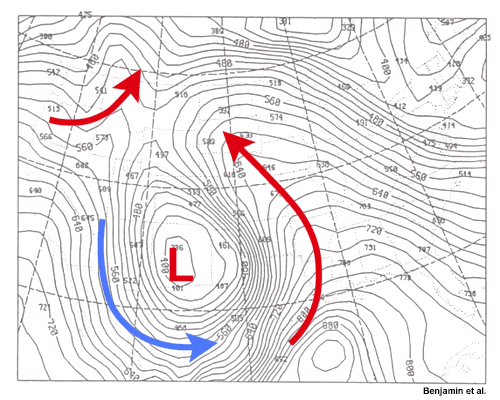
Now we'll examine the relative humidity field at 305K. High relative humidity, and thus cloud production, aligns very well with the axis of ascent within the warm conveyor belt

For comparison, let's now look at relative humidity plotted on the 500 mb pressure surface. 500 mb is a suitable choice here, as the range of pressures at 305K was approximately 400 mb to 700 mb over much of the domain. Quickly, we can see that the areas of high relative humidity do not align with areas of ascent that we saw earlier. If we examined additional pressure surfaces we would likely be able to "connect the dots" and envision a sloped ascent between the various RH maxima on each level - but clearly, isentropic analysis provides a more comprehensive and intuitive view of ascent in this case.

To enhance our view of conveyor belts and ascent/descent, we can view system relative winds instead of total wind as in the previous examples.
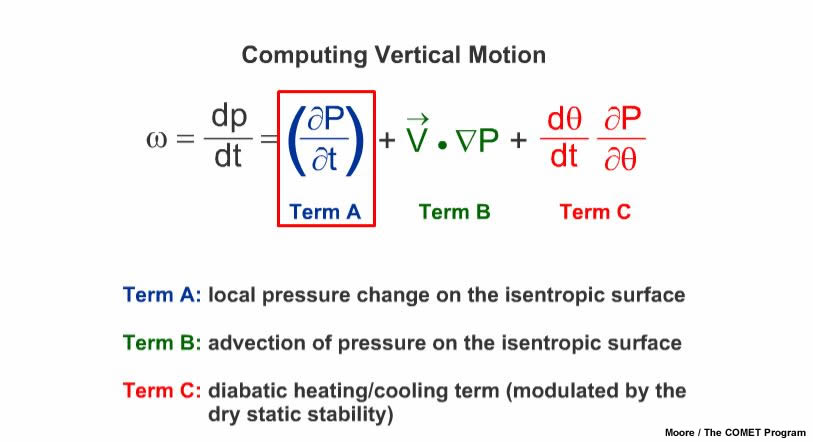
Typically, where wind speeds are large and directed along the pressure gradient, the advective change (term 2 above) will dominate the other terms (Saucier, 1955) and therefore yield a reasonable estimate of significant synoptic scale vertical motion. Typical methods of calculating the system-relative wind are to subtract a system-relative motion vector from the total wind. This is accomplished by tracking the vorticity center on the given isentropic surface for a number of hours (usually 6 to 12), or tracking the position of the shortwave trough on the isentropic surface.
The latter system-relative motion calculation was performed for the 296K level that we examined earlier. Let's take a look at the implications for the system, with system-relative wind barbs plotted in the question below.
Question 2 of 2
Outline the full extent of the area of system-relative ascent using the red pen, and descent using the blue pen.
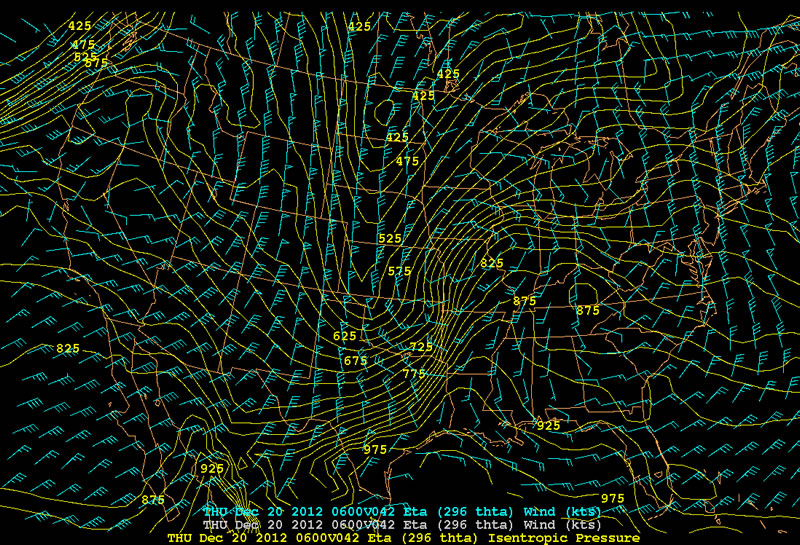
| Tool: | Tool Size: | Color: |
|---|---|---|
The red area of ascent and blue area of descent look similar to what we outlined earlier with ground-relative total winds. However, if we examine the strength and direction of the descent and ascent, we see a different picture. The system-relative winds in the second case show the wrap-around flow within the TROWAL much more clearly, while the descent is much more channeled behind the northern and central portion of the cold front, as we would expect from classical norwegian cyclone model and conveyor belts. Thus, these system-relative defined axes of strong ascent and descent are better predictors of where precipitation development is most likely.
Now that we have seen several uses for and ways to plot potential temperature and equivalent potential temperature, we will move forward with examining a midlatitude cyclone in a more isentropic sense in the lab activity. Some information, such as selecting the most appropriate isentropic surface, and moisture variables for use with isentropic analysis, was not covered in detail here, but can be found within the Isentropic Analysis webcast by Jim Moore here: https://www.meted.ucar.edu/training_module.php?id=94
Next Steps: Lab Activity
This lab activity allows you to explore the thermal and dynamic structure of a midlatitude cyclone using the isentropic concepts presented here, as well as in the more standard pressure level sense. You can examine plan-view loops of several variables in the first set of tabs below, and cross-sections are available in a second set of tabs, along with a map showing their locations. Five times are presented - the loops begin at 12Z on Mar. 2, 2012 and subsequent images are shown at 6-hr intervals. All data are NAM analyses from NOAA. A set of questions precedes the imagery - consult your instructor to determine which questions and/or maps are assigned.
Questions
- Examine the loop of MSLP and 1000 mb temperatures in the first set of tabs to familiarize yourself with the case. Describe the cyclone that develops in terms of its initial location and strength (in mb), the direction of its track and final location in frame 5, and characterize any associated fronts in terms of frontal type and their locations relative to the center of low pressure
- Examine the loop of 850 mb potential temperature (theta) and winds in the second tab. Describe the evolution of cold air and warm air advection regimes in terms of areal size, position within the cyclone, and relative strength over time. Outline the total area of warm air advection in red, and cold air advection in blue, on the 3rd frame map here. Hatch or shade in the area of strongest warm air and cold air advections. This map has a white background for those wishing to print and peform hand analysis instead of using an electronic graphics program: 850mb Theta and Winds, Frame 3
- Examine the loop of 500 mb absolute vorticity and heights in the third tab. Describe the evolution of the vorticity maximum associated with the cyclone in terms of areal size, position within the cyclonesystem, and relative strength over time. Outline the area of positive vorticity advection in red on the 3rd frame map here. This map has a white background for those wishing to print and peform hand analysis instead of using an electronic graphics program: 500mb Vorticity and Heights, Frame 3
- Examine the loop of 300 mb isotachs and heights in the fourth tab. Describe the evolution of the jet streak associated with the cyclone in terms of areal size and relative strength over time. Describe any theoretical convergence/divegence and transverse circulations that are relevant with respect to the strength and location of the cyclone center. Analyze the jet streak axis and its quadrants, labeling areas of upper level convergence with a red "C" and divergence with a blue "D" on the 3rd frame map here. This map has a white background for those wishing to print and peform hand analysis instead of using an electronic graphics program: 300mb Isotachs and Heights, Frame 3
- Now examine the loop of pressure and system-relative winds on the 296K surface. Describe the evolution of ascent and descent on the 296K surface in terms of areal size, position within the cyclone system, and relative strength over time. Analyze vertical motion by outlining the area of ascent in red and descent in blue on the 3rd frame map here. Hatch or shade in the strongest ascent and descent. This map has a white background for those wishing to print and perform hand analysis instead of using an electronic graphics program: 296K Pressure and System Relative Winds, Frame 3
- How does the size of the areas of ascent and descent on the 296K surface compare to that of the 850mb warm air and cold air advection areas? The 500 mb positive vorticity advection areas? The 300 mb divergent areas?
- How does the position of the areas of ascent and descent on the 296K surface (relative to the cyclone center) compare to that of the 850mb warm air and cold air advection areas? The 500 mb positive vorticity advection areas? The 300 mb divergent areas?
- Examine the cross sections in the second set of tabs. Two of the cross sections cut through the warm front, while two cut through the cold front. Compare and contrast the slope of and static stability surrounding the: 1) warm front and, 2) cold front as revealed by the potential temperature contours in the cross sections. Cite specific cross-sections, contour values and animation frames as needed to support your answers.
- Characterize any differences in frontal structure revealed by the northern and southern cross sections through the cold front; do the same for the eastern and western cross sections through the warm front
- Where do the fronts typically reside with respect to the jet core? Is there any difference in this regard between the warm and cold front? Briefly explain.
References:
Bluestein, H., 1992: Synoptic-Dynamic Meteorology in Midlatitudes: Principles of Kinematics and Dynamics, Volume 1, p. 22
Byers, H. R., 1038: On the Thermodynamic Interpretation of Isentropic Charts. Mon. Wea. Rev., 66, 63-68.
Rossby, C. G. et al., 1937: Isentropic Analysis. Bull. Amer. Meteor. 18, 201-209.
Saucier, W.J., 1955: Principles of Meteorological Analysis, The University of Chicago Press, Chapter 8, p. 250-261
